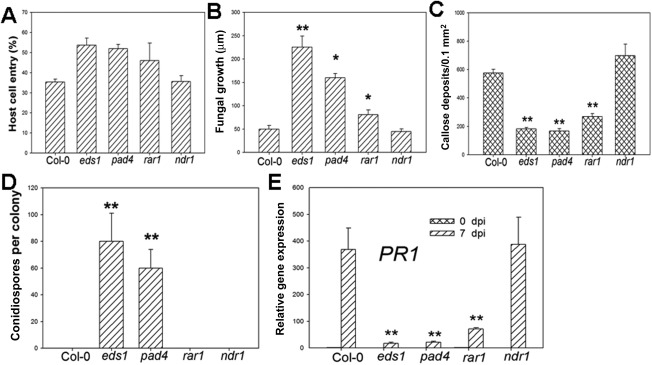Figure 3.

EDS1 (Enhanced Disease Susceptibility 1) and PAD4 (Phytoalexin Deficient 4) are required for Oidium heveae HN1106‐triggered disease resistance and defence responses in Arabidopsis. Four‐week‐old Arabidopsis wild‐type (WT) Col‐0 and mutants were inoculated with O. heveae HN1106. (A) Quantitative assessment of host cell entry rates. Data represent the mean ± standard deviation (SD) of three experiments, each based on five to seven leaves per plant line. (B) Quantitative analysis of hyphal growth of O. heveae HN1106 at 48 h post‐inoculation (hpi). Leaves were stained with Coomassie brilliant blue at 48 hpi, and hyphal lengths per colony were measured from photographs using mie 3.1 software. At least 10 colonies were measured for hyphal length. *Significant difference from Col‐0 (Student's t‐test, P < 0.05). **Significant difference from Col‐0 (Student's t‐test, P < 0.01). (C) Average numbers of callose deposits per microscope field of 0.1 mm2 on Col‐0 and mutant leaves determined at 7 days post‐inoculation (dpi). **Significant difference from Col‐0 (Student's t‐test, P < 0.01). (D) The numbers of conidiospores per colony were counted at 10 dpi. Data represent the mean ± SD of at least 20 fungal colonies per plant line. **Significant difference from Col‐0 (Student's t‐test, P < 0.01). (E) The abundance of PR1 (Pathogenesis‐Related 1) mRNA was determined at the indicated time points by quantitative polymerase chain reaction. Data represent the mean ± SD of three RNA replicates. **Significant difference from Col‐0 (Student's t‐test, P < 0.01). These experiments were repeated twice with similar results.
